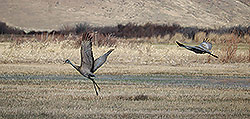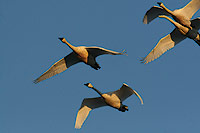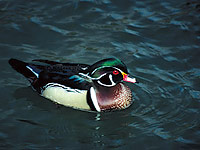 February marks the transition from winter to spring here in southern Utah. Longer daylight hours act as a trigger, a stimulus for birds to begin their northward migration toward their breeding grounds.
February marks the transition from winter to spring here in southern Utah. Longer daylight hours act as a trigger, a stimulus for birds to begin their northward migration toward their breeding grounds.
Here in Canyon Country, the first wave of migrants are the waterfowl – ducks and geese. As the rivers, lakes, and wetlands begin to green up and lose their ice, aquatic invertebrate activity increases and fields begin to thaw exposing seeds and grains left over from the fall. A state of migratory restlessness, called zugunrhue, initiates the bird’s call to migrate.
Of course, sometimes the weather thwarts the best-laid plan. Snow, cold, ice, storms, and other factors contribute to forcing these birds to stage or spend time in one location until the weather conditions become favorable for them to depart and continue on their sojourn. Perfect for birders, not so much for the birds.
Local areas such as Ken’s Lake; the Matheson Wetlands; along the Colorado, Delores, Green, or San Juan rivers; Recapture Reservoir; Desert Lake Waterfowl Management Area, and numerous smaller lakes and reservoirs offer great opportunities to view waterfowl.
Mixed flocks consisting of dabbling ducks, such as mallards, wigeons, wood ducks, and pintails mix in diving ducks such as goldeneyes, scaups, buffleheads, and mergansers. Canada geese may also be present, as well as the occasional snow goose or tundra swan, to provide birders with opportunities to view the diversity of birds but to also watch courtship behavior between bonding pairs.
Interestingly, the resident Canada geese may already be sitting on eggs as these other birds pass through the region. These early nesters may utilize a small island in the river channel that offers protection from predators and will that remain above the water until spring run-off raises the river level. 
Other avian species, in addition to the waterfowl, also show up during this time of year. These early-season migrants represent a mixture of songbirds, raptors, and shorebirds; their daily arrivals are noted like incoming flights to an airport. Sandhill cranes, blackbirds, phoebes, yellow-rumped warblers, and kinglets are some other early-season migrants that mix in with either the resident species or those that winter in Canyon Country but will soon embark on their own northward or upward migration. An example of this group is the rough-legged hawk.
Roughies, as birders like to call them, winter south of their Arctic breeding area across the U.S. and parts of Canada. Related to red-tailed hawks (both are soaring hawks or Buteos), the rough-legged hawk’s common name refers to their feathered legs. Birds of open country, rough-leggeds may perch on power poles or fence posts, in tree tops, or on the ground making them easy to see. They hunt small mammals and rodents and are a common sight in winter along Interstate 70. But when the migratory itch happens, these birds head back to their northern haunts.
The Cornell Lab of Ornithology’s eBird site (ebird.org) is a great resource to track the arrivals or departures of the Canyon Country avian wildlife. Local or traveling birders, agency personnel, feeder watchers, or researchers populate the site with sightings of common or unusual species. Photographs or sonograms (vocal recordings) and comments may be added to the postings. Maps provide hotspot locations or links to other sightings. This free-to-use site is an invaluable tool to record and publish bird sightings across the globe, for beginning or advanced birders. Good birding!